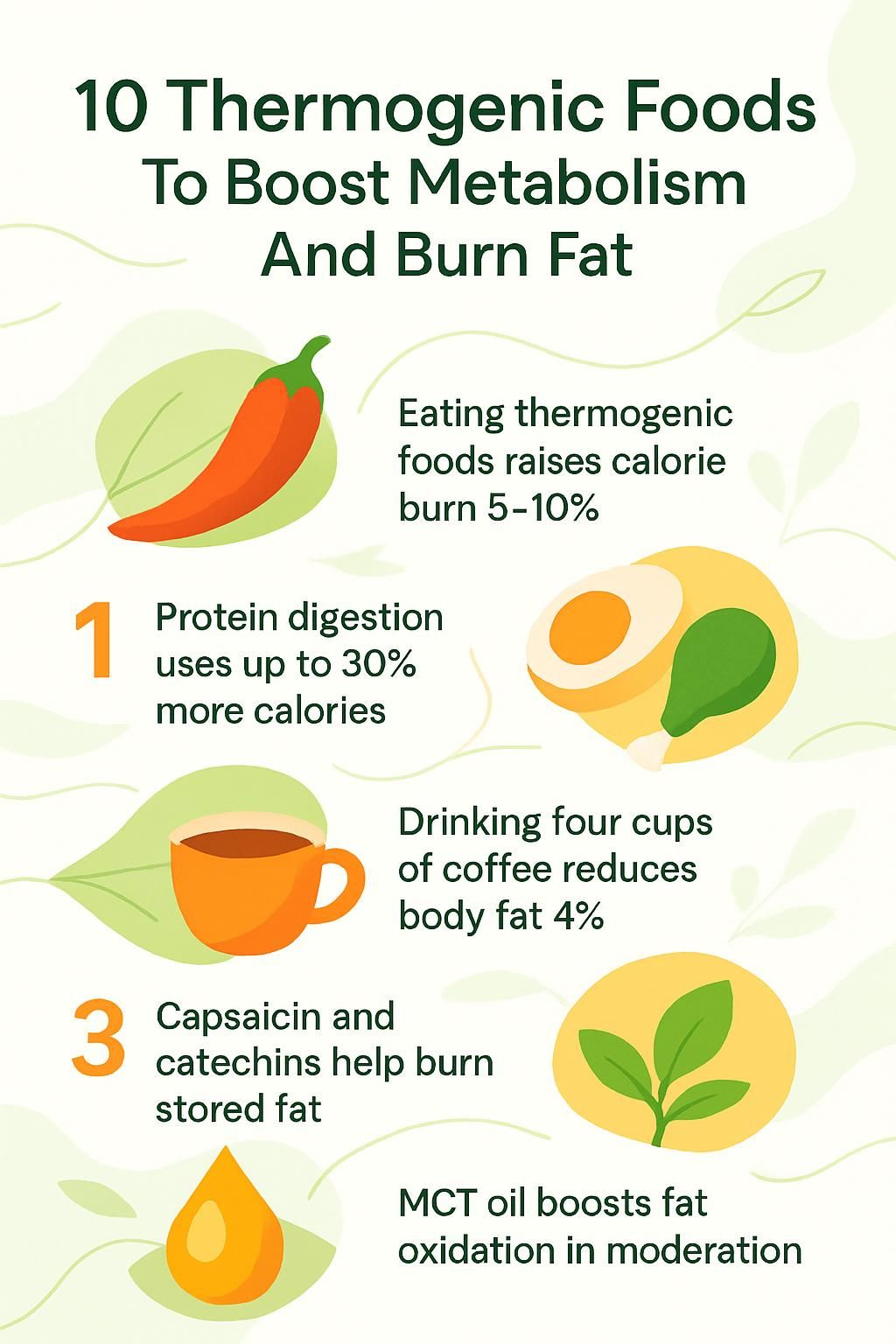10 Thermogenic Foods To Boost Metabolism And Burn Fat
Our Nutrition Assistant AI Suite will transform your body. You will lose fat, get toned, and build muscle. Gain confidence and optimal health.
Struggling to boost your metabolism and lose stubborn belly fat? Thermogenic foods can help you burn more calories through thermogenesis, the heat your body creates while digesting food.
This guide highlights science-backed picks like lean proteins, green tea, chili peppers, and more. You will learn simple ways to use these foods to support weight loss, steady energy, and better health.
Key Takeaways
- Thermogenic foods such as lean protein, green tea, and chili peppers can raise daily calorie burn by about 5 to 10 percent through increased energy expenditure (PLOS One, July 2013).
- Protein-rich foods, including chicken, fish, beans, and dairy, can cost your body up to 30 percent of their calories to digest, which is higher than carbs or fats.
- In a Harvard study from January 2020, drinking four cups of coffee per day reduced body fat by about 4 percent.
- Capsaicin in hot peppers increases metabolism; green tea’s catechins help your body use stored fat for energy. Both have documented effects on weight management.
- MCT oil from coconut can increase fat oxidation at up to two tablespoons per day, though some people experience digestive side effects.

What are thermogenic foods?

Thermogenic foods make your body burn more calories during digestion and absorption. This effect comes from the thermic effect of food, or TEF, which accounts for about 10 to 15 percent of your total daily energy use.
Classic examples include lean meats, fish, eggs, hot peppers that contain capsaicin, green tea with catechins, and coffee with caffeine. These foods stimulate your nervous system, which can raise metabolic rate and calorie burn.
Eating foods with a high thermic effect can help you burn extra calories without extra effort.
After eating spicy meals or sipping green tea, you might feel a slight rise in body temperature. That warmth is your body using more energy to break down nutrients.
When I added more protein and a bit of spice to my meals, I felt warmer and more focused during workouts. Studies suggest these changes can support weight management when paired with a healthy diet and regular movement.
How do thermogenic foods boost metabolism and burn fat?
Understanding thermogenic foods helps you see how they influence metabolism and fat loss. High-protein choices, like lean meats or legumes, make your body work harder during digestion.
Protein can require 15 to 30 percent of its calories to digest. Carbohydrates need about 5 to 10 percent, while fats use roughly 0 to 3 percent. This higher thermic effect helps you burn more calories even at rest.
Foods with capsaicin, such as chili peppers or jalapeños, can raise body temperature and metabolic rate. A study in PLOS One, July 2013, found that capsaicin increased energy expenditure and post-meal fat burning.
Caffeine in coffee and catechins in green tea provide an extra lift. Caffeine can temporarily speed up calorie burn. A 2020 Harvard study found that four cups of coffee per day lowered body fat by about 4 percent.
Green tea’s main antioxidant, EGCG, helps break down stored fat so your body can use it for energy. Cold water may help a little as your system warms the liquid, which costs energy. Even mild dehydration can reduce calorie burning by about 2 percent, according to the American Council on Exercise.
Used with a balanced diet, these thermogenic foods can increase total energy expenditure and support fat loss over time.
Top thermogenic foods to include in your diet
Some foods can raise calorie burn, support steady energy, and make weight management easier. The options below fit into most eating styles.
Which lean animal proteins help increase metabolism?
Chicken and turkey breast are lean proteins that can help boost your metabolism. They take more energy to digest than carbohydrates or fats, which raises your thermic effect of food.
Digesting protein uses about 15 to 30 percent more energy, compared with 5 to 10 percent for carbs and as low as 0 to 3 percent for fat. The American Heart Association recommends fatty fish, such as salmon and tuna, twice per week.
These seafood options deliver protein and omega-3 fatty acids, which support body weight regulation. Plain, low-fat yogurt adds quality protein plus minerals important for thyroid health, including iodine, zinc, and selenium.
Grill or roast poultry to keep meals lower in calories while still enjoying the higher thermic effect of protein. Protein also supports muscle, which helps keep metabolism higher during a weight loss journey.
What plant-based proteins have thermogenic effects?
Lentils, beans, tofu, nuts, and tempeh increase calorie burn because protein takes more energy to digest. Research in Nutrition and Metabolism (2014) shows protein digestion raises oxygen demand, which increases energy use.
Cooked lentils offer about 18 grams of protein per cup and provide iron, magnesium, and potassium for few calories. Beans such as black beans, chickpeas, and kidney beans support weight goals and fat oxidation. Choose low-sodium canned beans when possible.
Tempeh is a satisfying meat alternative that promotes fullness. Many people feel satisfied longer after meals that feature these foods, thanks to the thermic effect of food.
I swapped my afternoon chips for roasted chickpeas. Energy stayed more stable, and it was easier to meet my calorie target.
How do fish and seafood aid fat burning?
Fish and seafood provide high-quality protein that costs more energy to digest than carbs or fats. Your body burns extra calories as it breaks down these foods.
Seafood also supplies omega-3 fatty acids, which can support resting metabolic rate and heart health. The American Heart Association suggests eating fatty fish at least two times per week.
If you do not eat seafood, omega-3 supplements may still help your weight loss efforts. Making seafood a regular, low-calorie protein choice can raise metabolism and improve meal satisfaction.
Which foods contain capsaicin for metabolism boost?
Chili peppers are the best-known source of capsaicin, the compound that makes them hot. Paprika contains smaller amounts. Capsaicin can raise metabolic rate and stimulate fat burning, as reported in PLOS One, July 2013.
Add diced peppers to soups, salads, and stir-fries. People with reflux, ulcers, or high blood pressure should use spicy foods carefully, since they can irritate the stomach.
Research suggests frequent intake of capsaicin-rich foods can increase thermogenesis and may reduce appetite. Green tea is another popular metabolic booster covered below.
What are the benefits of green tea for metabolism?
Green tea is a reliable thermogenic drink. It contains catechins, mainly EGCG, which work with caffeine to increase energy expenditure and fat burning.
Research in Advances in Nutrition (2013) and Antioxidants in Sport Nutrition (2014) shows these compounds help you burn more calories daily. Up to four cups per day is generally safe. People with high blood pressure may prefer three.
These polyphenols help break down stored fat so your body can use it for fuel. Some people notice a small rise in basal metabolic rate after adding green tea.
After I traded my sweet drink for a cup of unsweetened green tea, mid-afternoon energy became more steady. Green tea is not recommended for children, pregnant or breastfeeding women, or those with certain conditions such as kidney disease or anemia. If it fits your health status, swapping sugar-heavy drinks for green tea may help you keep calories lower and support weight loss.
How does coffee contribute to fat burning?
Coffee is a natural thermogenic option. Caffeine can increase calorie burn for a short time and promote fat oxidation, which helps your body tap stored adipose tissue for energy.
A 2020 Harvard study found that four cups per day lowered body fat by about 4 percent in overweight adults. A moderate intake, about 400 milligrams of caffeine daily or roughly two to three cups, is a common guideline for healthy adults.
Coffee can also improve workout alertness, which may increase calories burned during exercise. I feel more focused lifting weights after a small black coffee.
What role does ginger play in boosting metabolism?
Ginger may slightly increase the thermic effect of food and boost metabolism for a short time. Study results are mixed; ginger helps more with nausea than fat loss.
It still supports a healthy pattern when it replaces sugary sauces or flavors low-calorie meals like stir-fries or tea. Fresh or powdered ginger is safe for most adults in small amounts.
People with gallstones, bleeding issues, or high blood pressure should limit intake and talk with a clinician. Pregnant women should keep daily intake under 1 gram and avoid using it more than three days in a row. Pairing ginger with green tea or chili peppers may add small benefits.
How can cinnamon help increase calorie burning?
Cinnamon can act as a gentle thermogenic spice. Up to 6 grams per day appears safe for most healthy adults. Your body may use slightly more energy processing cinnamon’s natural compounds.
Some research suggests cinnamon can help reduce appetite and support glucose control, which may help with belly fat over time. People with ulcers, gastritis, or those who are pregnant or breastfeeding should avoid it.
Add one half teaspoon to oatmeal, smoothies, or coffee for flavor and potential benefits. Always speak with your doctor if you take diabetes or heart medications.
Which iron, zinc, and selenium-rich foods support metabolism?
Iron, zinc, and selenium support a healthy thyroid, the gland that helps regulate metabolic rate. Meat, poultry, and seafood are rich in these minerals and tend to be lower in saturated fat when you choose lean cuts.
Nuts, legumes, and dairy also contribute. Lentils offer protein, fiber, magnesium, potassium, and meaningful iron per cooked cup.
Shortfalls in these minerals can slow metabolism by affecting thyroid function and energy production. Eggs, sunflower seeds, oysters, beef, yogurt, and pumpkin seeds can help you meet daily targets. A varied mix of these thermic foods supports energy balance and a healthy weight.
How does MCT oil like coconut oil affect fat loss?
MCT oil, found in coconut oil, contains medium-chain triglycerides that your body absorbs quickly and burns for energy. Studies show MCTs can raise metabolism and increase fat oxidation compared with long-chain fats.
Using up to two tablespoons per day has been linked with higher energy use and less belly fat in some studies. Try adding a little to smoothies or using it in low-heat cooking. I noticed better fullness after swapping my usual cooking oil for coconut oil in small amounts.
Use MCT oil carefully. Large amounts may cause diarrhea or raise LDL cholesterol. Keep intake within the recommended range and include it as part of a balanced diet.
Additional thermogenic foods to consider
Several other foods and drinks offer modest thermogenic effects. These options can support your plan without adding many calories.
What are the benefits of turmeric for metabolism?
Turmeric contains curcumin, which may increase body temperature slightly and support energy use at rest. Some studies suggest curcumin improves cellular redox balance and helps regulate blood sugar after meals.
Because turmeric is low in calories, it fits well into many dishes. Use it fresh or as a powder in soups, pasta sauces, golden milk, or on vegetables with black pepper, which helps absorption.
I enjoy golden milk after workouts, which seems to ease soreness. Avoid turmeric if you have gallstones or take certain medications, including MAOIs like selegiline, phenelzine, moclobemide, isocarboxazid, or tranylcypromine. People who are pregnant or breastfeeding should check with a healthcare provider first.
How does garlic support fat burning?
Garlic can support fat metabolism as part of a healthy eating pattern. About one clove per day, minced or crushed, may help your body use more energy while digesting.
Compounds in garlic affect cellular pathways tied to energy use. Some people notice better appetite control when garlic boosts the flavor of low-calorie meals.
Avoid garlic if you have low blood pressure, stomach pain, are pregnant or breastfeeding, recently had surgery, or take blood thinners. Garlic is not for babies, but it can help adults manage weight when combined with dietary fiber and regular activity.
What effects does hibiscus tea have on metabolism?
Hibiscus tea can provide a light thermogenic effect and mild diuretic action, which may support weight management. Up to three cups per day is typically safe for adults who are not pregnant or breastfeeding.
People with kidney or liver issues should avoid it. While its effect is smaller than chili peppers or green tea, hibiscus tea is a flavorful, calorie-free drink that fits many meal plans.
How can yerba mate boost your metabolism?
Yerba mate contains caffeine and polyphenols that can raise energy expenditure and enhance fat oxidation. Some people drink up to about 50 ounces a day for these effects.
Avoid yerba mate if you have anxiety, insomnia, or high blood pressure. People with diabetes should talk with a clinician first. I found that swapping sugary drinks for yerba mate improved focus and reduced afternoon fatigue.
Like other thermogenic foods, it makes your body work a bit harder while processing meals, which can help you burn more calories.
What are the benefits of eating thermogenic foods?
Thermogenic foods can increase daily energy use and support weight control. The benefits come from a mix of higher calorie burn, better fat use, improved fullness, and steadier digestion.
How do thermogenic foods increase energy expenditure?
These foods raise energy use by nudging your metabolic rate higher. Protein-heavy foods, such as lean meats and plant proteins, can make your body burn 15 to 30 percent more calories during digestion compared to carbs and fats.
Chili peppers, coffee, and green tea also help due to capsaicin, caffeine, and catechins. Cold water adds a small boost because your body warms it to body temperature. The American Council on Exercise notes that dehydration can reduce calorie burning by about 2 percent.
High-fiber eating patterns, with around 35 to 45 grams per day, have been linked with greater energy use during digestion, according to The American Journal of Clinical Nutrition (March 2017).
In what ways do thermogenic foods enhance fat oxidation?
Chili peppers, green tea, and coffee can help your body use more fat for fuel. Capsaicin raises body temperature and calorie burn at rest.
Green tea’s catechins, especially EGCG, encourage the breakdown of stored fat, especially when paired with caffeine. A 2013 review found that green tea promoted greater fat loss. Coffee at about four cups per day reduced body fat by roughly 4 percent in one study.
MCT-rich fats, like coconut oil, can speed fat breakdown compared with other fats. Seafood protein has a high thermic effect, which means your body spends more energy digesting it. Together, these foods support higher fat use throughout the day.
How can thermogenic foods help regulate appetite?
Thermogenic foods help manage hunger by boosting satiety and supporting hormone balance. Lean meats, eggs, tofu, and dairy provide amino acids that signal fullness, which can reduce calorie intake.
Fiber-rich foods like almonds, berries, and oatmeal slow digestion and help you feel satisfied longer. Capsaicin and cinnamon may mildly reduce appetite. Apple cider vinegar may also delay stomach emptying, which can curb snacking.
Unsweetened green tea or black coffee can cut between-meal cravings for some people. Many notice fewer urges to overeat after they add these choices to their routine.
What is the impact of thermogenic foods on digestion?
After appetite improves, digestion often follows. Protein-rich foods such as lentils and lean meats require more energy to process, which can create a gentle warming effect.
Research in the Journal of Nutrition and Metabolism (2014) shows protein digestion raises oxygen demand. High-fiber foods like oatmeal and broccoli promote steady blood sugar and better gut health.
I replaced my usual cereal with oatmeal and felt full for hours. Adding thermogenic foods can support smoother digestion and a slightly higher calorie burn.
How do thermogenic foods support long-term weight management?
Thermogenic foods can help you burn more calories throughout the day. Capsaicin-rich peppers, lean proteins, and even small amounts of dark chocolate can encourage your body to use stored fat.
Green tea and coffee support a higher metabolic rate, which can lead to steady fat loss over time. These foods also help manage appetite, which makes it easier to maintain a healthy weight.
For best results, combine thermogenic foods with regular exercise and enough sleep. Nutrient-dense choices that include iron, zinc, and selenium support thyroid health and overall metabolism.
How can you incorporate thermogenic foods into your diet?
Small daily changes work best. Build habits that fit your taste, schedule, and budget.
How to add cinnamon and ginger to your meals?
Use up to 6 grams of cinnamon per day in oatmeal, smoothies, or baked goods. Stir a little into Greek yogurt or coffee for flavor and a possible metabolic nudge.
Grate fresh ginger or use powdered ginger in stir-fries, soups, and teas for warmth and aroma. People with certain conditions should limit ginger; those who are pregnant should keep it under 1 gram per day.
Pair these spices with green tea or lean protein for a simple, balanced approach.
Why replace sugary drinks with green tea or coffee?
Sugary drinks add quick calories that can stall progress. Replacing them with green tea or coffee can lower daily sugar and support thermogenesis.
Green tea supplies catechins and caffeine, which can help you burn more calories and use stored fat. Up to four cups per day may be helpful. Coffee in moderate amounts also supports fat loss, as seen in the Harvard study.
Both drinks contain antioxidants and pair well with workouts. Trade an afternoon soda for a cup of green tea or simple black coffee to build momentum.
How to use MCT oil in cooking and smoothies?
Start with 1 to 2 teaspoons of MCT oil in smoothies for a quick energy lift. Gradually work up to a daily total of two tablespoons, if tolerated.
Use MCT oil in salad dressings or drizzle it over roasted vegetables. Some people blend it into coffee for a creamy texture and steady energy.
Do not heat MCT oil to high temperatures. Too much can cause stomach upset or raise LDL cholesterol, so stick to modest amounts.
What are good nut and seed snacks for energy?
Almonds and pistachios are smart snacks with fiber, healthy fats, and protein. A small handful can curb hunger and keep energy steady.
Choose unsalted, unroasted options to avoid extra sodium and preserve nutrients. Mix in sunflower or pumpkin seeds to add minerals and variety. Aim for about one ounce per snack.
How to include lean proteins and vegetables in every meal?
Build meals with lean proteins such as skinless poultry, seafood, eggs, or low-fat dairy. Fill at least one quarter of your plate with protein.
Add plant-based proteins like lentils, beans, or tofu to salads and grain bowls. Fill half your plate with vegetables, including broccoli and other cruciferous picks, for fiber and fullness.
Round out the plate with a small portion of healthy fats. This balance supports metabolism and satiety.
What are common myths about thermogenic foods?
Misunderstandings can lead to frustration. Clear facts help you make better choices and stay consistent.
Why don’t thermogenic foods alone lead to weight loss?
Thermogenic foods help raise calorie burn, but they are not a magic bullet. You still need an overall plan that includes movement and calorie awareness.
Research shows thermogenic foods typically raise daily energy expenditure by about 5 to 10 percent. That helps, but it cannot erase a large calorie surplus.
I saw real changes only after pairing spicy foods and ginger with regular exercise and a healthier plate. Consistency is what moves the needle.
Do all spices and teas have the same thermogenic effect?
No. Spices and teas vary because their active compounds differ. Green tea, matcha, and yerba mate contain caffeine and catechins that tend to raise energy spend more than cinnamon or turmeric.
Capsaicin from chili peppers usually produces a stronger effect than ginger or cinnamon. Your response can vary based on health, caffeine tolerance, and overall diet.
Use a mix that fits your taste and routine. Not every spice or tea will affect metabolism to the same degree.
What lifestyle changes complement thermogenic foods?
Daily habits can multiply the benefits of thermogenic foods. Think of them as small gears that help the whole system run better.
How does regular exercise support metabolism?
Exercise raises metabolism during activity and for hours afterward through excess post-exercise oxygen consumption, called EPOC. Your body burns about five calories per liter of oxygen used.
High-intensity interval training creates a strong afterburn. Strength training builds lean muscle, and more muscle means higher calorie burn at rest.
Daily activity helped me maintain energy and control weight more easily. Combine thermogenic foods with a simple workout plan for better results.
Why is staying hydrated important for fat burning?
Hydration helps your body burn fat efficiently. The American Council on Exercise reports that dehydration can reduce calorie burn by up to 2 percent.
Cold water can add a tiny boost since your body warms it to body temperature. A practical target is daily ounces equal to about half your body weight in pounds.
Many people notice better energy and fewer cravings once they drink enough water.
How do sleep and stress management affect metabolism?
Adults need 7 to 9 hours of sleep for a healthy metabolism. The Journal of Lipid Research (September 2019) links short sleep under 5 hours with problems in appetite control and energy use.
Stress raises cortisol, which can push the body to store fat and slow calorie burn. Simple habits like brief journaling or 10 minutes of meditation before bed can help.
When I improved my bedtime routine, daytime energy became more stable. Small steps make a difference.
Conclusion
Adding thermogenic foods to daily meals can help boost your metabolism and support fat loss. Lean proteins, green tea, and spicy foods help you burn more calories while keeping energy steady.
Pair these choices with water, fiber-rich foods, sleep, and regular activity for stronger results. Choose a variety of options you enjoy so the plan sticks.
Small changes, repeated often, can help you reach long-term weight goals. Thermogenic foods are a practical way to support appetite control, better digestion, and lasting wellness.
FAQs
1. What are thermogenic foods and how do they support overall health?
Thermogenic foods increase the body’s energy use during digestion, which can help boost metabolism. Eating these foods may help burn more calories, supporting weight management and overall health.
2. Can eating thermogenic foods alone help burn fat effectively?
Eating thermogenic foods can help increase calorie burn, but combining them with regular exercise and a balanced diet is important for effective fat loss and better overall health.
3. Which nutrients in thermogenic foods contribute to metabolism and fat burning?
Many thermogenic foods contain protein, fiber, or certain plant compounds that raise energy use. For example, chili peppers have capsaicin, which can increase calorie burn. These nutrients also support overall health by aiding digestion and providing essential vitamins.
4. How can I include thermogenic foods in my daily meals to improve overall health?
You can add thermogenic foods like lean meats, green tea, or spicy peppers to your meals. I started adding green tea to my breakfast and noticed I felt more alert. Including these foods regularly supports metabolism and can contribute to better overall health.







